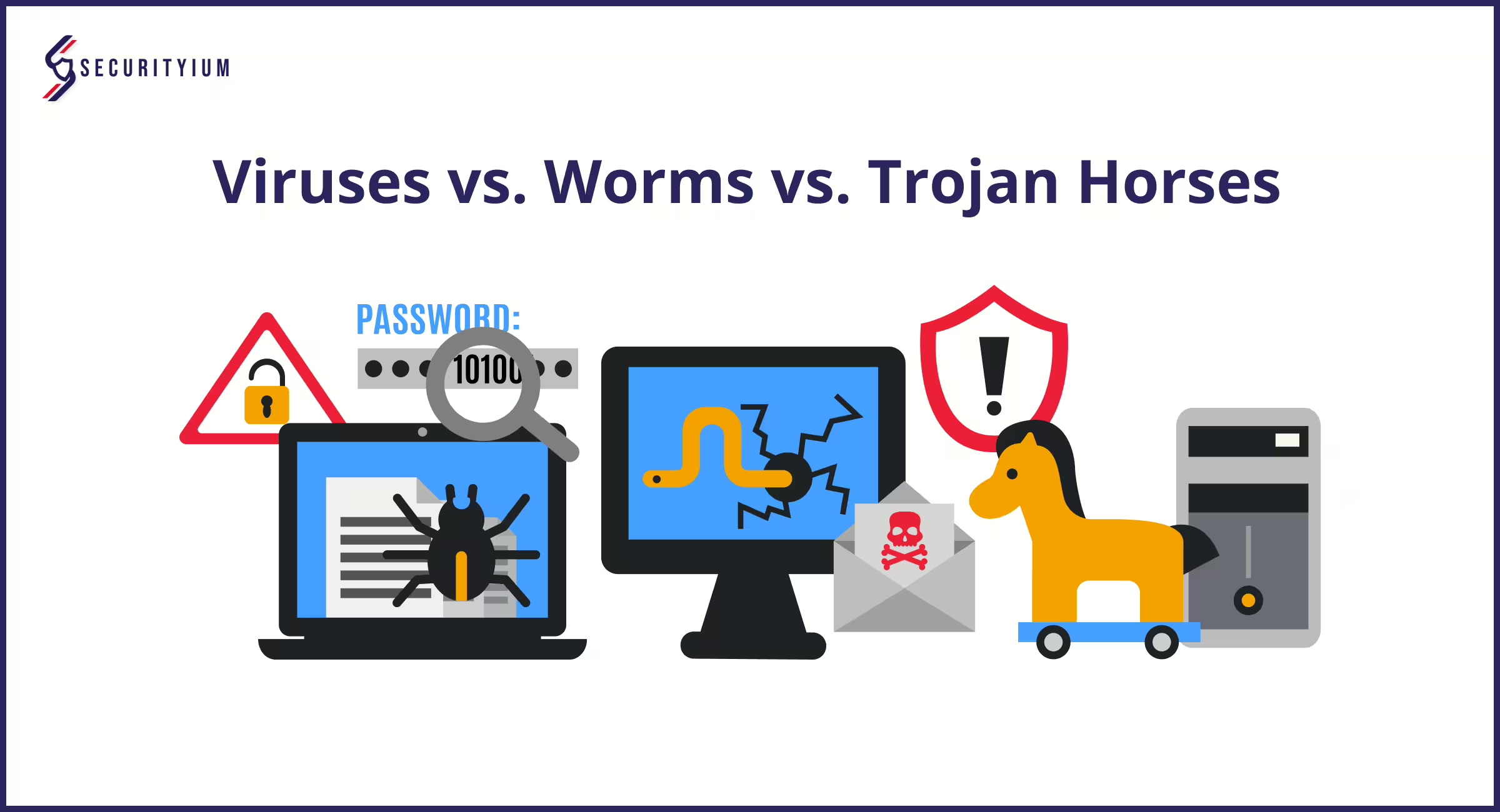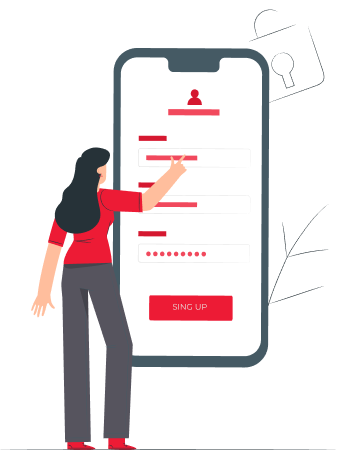
Oct 11, 2024 Information hub
Viruses vs. Worms vs. Trojan Horses: A Detailed Guide With Prevention Tips
The threat of malicious software, or malware, is a serious concern. Malware comes in different forms, with viruses, worms, and Trojan horses being among the most common. Understanding how each of these operates, their unique characteristics, and how to defend against them is critical for keeping systems secure.
This guide will break down what viruses, worms, and Trojan horses are, how they work, and give real-world examples to better understand their behaviors.
What Is a Virus?
A virus is a type of malicious software that attaches itself to a legitimate program or file. When the infected file or program is run, the virus activates and begins to perform malicious activities. These can include corrupting data, spreading to other files or programs, or crashing the system.
Key Characteristics of a Virus:
- Attachment to Host Files: A virus needs to attach itself to another file or program to work. It cannot function independently.
- Spreading Mechanism: Viruses spread through the sharing of infected files or programs between computers, such as via email attachments or downloads.
- User Interaction Required: The virus requires the user to execute the infected file or program for it to activate and spread.
- Destructive Behavior: Viruses can delete files, corrupt data, or even render a system inoperable.
How Does a Virus Work?
- Infection: A virus attaches itself to a host program or file (e.g., a word document or software installer).
- Execution: The virus remains dormant until the infected file is opened or run.
- Spreading: When the infected file is executed, the virus can infect other files or spread to other systems if shared through removable drives or emails.
- Damage: Once activated, viruses can perform various malicious tasks, such as corrupting files, slowing system performance, or stealing sensitive information.
Example of a Virus:
The ILOVEYOU Virus (2000) is one of the most notorious viruses in history. Disguised as a love letter sent via email, it tricked users into opening an infected attachment. Once opened, the virus overwrote files, corrupted system files, and sent itself to all contacts in the user’s email address book, spreading rapidly across the globe.
What Is a Worm?
A worm is a type of malware that can replicate itself and spread across networks without needing to attach itself to a file or program. Unlike viruses, worms exploit system vulnerabilities and don’t require user action to spread. Worms can quickly infect large numbers of systems, consuming resources and slowing down networks.
Key Characteristics of a Worm:
- Self-Replicating: Worms can copy themselves and spread independently, without attaching to other files or programs.
- Network-Based Propagation: Worms exploit network vulnerabilities and spread automatically across systems connected to the same network.
- No User Interaction Required: Unlike viruses, worms don’t need the user to open a file or run a program. They spread autonomously.
- Resource Consumption: Worms often consume bandwidth and system resources, causing slowdowns and even crashing systems.
How Does a Worm Work?
- Infection: A worm enters the system by exploiting vulnerabilities, such as outdated software or insecure network settings.
- Replication: Once inside, the worm replicates itself and searches for other vulnerable systems on the same network.
- Spreading: The worm spreads to other systems by exploiting similar vulnerabilities, using network resources like email servers or file-sharing protocols.
- Damage: Worms can cause significant damage by consuming system resources or carrying additional payloads like malware, ransomware, or spyware.
Example of a Worm:
The WannaCry Ransomware Worm (2017) spread rapidly across the globe by exploiting a vulnerability in Windows operating systems. Once infected, the worm encrypted users’ files and demanded a ransom in Bitcoin to restore access. WannaCry affected hundreds of thousands of computers worldwide, including major institutions like hospitals and banks, causing widespread disruption.
What Is a Trojan Horse?
A Trojan horse (or simply Trojan) is a type of malware that disguises itself as legitimate software to trick users into downloading and installing it. Unlike viruses and worms, Trojans do not replicate or spread on their own. They rely on social engineering to convince users to install them, after which they can steal information or allow attackers remote access to the system.
Key Characteristics of a Trojan Horse:
- Disguised as Legitimate Software: Trojans often look like useful or desirable programs, such as games, apps, or utilities, to deceive users.
- No Self-Replication: Trojans do not replicate or spread independently. Users must manually install them.
- Remote Access: Trojans can create a backdoor for attackers to remotely control the infected system.
- Information Theft: Many Trojans are designed to steal sensitive information, such as passwords, credit card numbers, or personal files.
How Does a Trojan Horse Work?
- Deception: The Trojan disguises itself as a legitimate or useful application (e.g., a free antivirus or software update).
- Installation: The user is tricked into downloading and installing the Trojan, often from unofficial or unsafe sources.
- Remote Access: Once installed, the Trojan can create a backdoor that allows attackers to remotely access and control the system.
- Damage: Trojans often lead to the theft of sensitive information, such as banking credentials or personal data, without the user’s knowledge.
Example of a Trojan Horse:
The Zeus Trojan (2007) is a well-known Trojan horse used to steal banking information. It disguised itself as legitimate software and was often distributed through phishing emails. Once installed, Zeus allowed attackers to steal login credentials for online banking and credit card information from infected users.
Key Differences Between Viruses, Worms, and Trojan Horses
Here’s a summary of the key differences between these three types of malware:
1. Mode of Operation:
- Virus: Attaches to legitimate programs or files and requires user interaction to activate.
- Worm: Spreads independently through networks by exploiting vulnerabilities, without attaching to other files or programs.
- Trojan Horse: Disguises itself as legitimate software and tricks users into downloading or installing it.
2. Propagation:
- Virus: Spreads through infected files shared between systems (e.g., email attachments, USB drives).
- Worm: Propagates across networks automatically, often through email systems or network vulnerabilities.
- Trojan Horse: Relies on social engineering tactics to deceive users into manually installing the malware.
3. User Interaction:
- Virus: Requires user action (e.g., opening an infected file) to activate and spread.
- Worm: Spreads automatically without user interaction by exploiting network vulnerabilities.
- Trojan Horse: Requires user interaction to install but does not spread on its own.
4. Damaged Caused:
- Virus: Can corrupt files, steal data, or disrupt system operations.
- Worm: Primarily consumes system resources, causing slowdowns or crashes. May carry other malicious payloads.
- Trojan Horse: Steals sensitive information, opens backdoors for remote access, and often goes unnoticed by the user.
5. Prevention and Removal:
- Virus: Use antivirus software and keep files updated to prevent infections.
- Worm: Install security patches, use firewalls, and check network activity to prevent worms.
- Trojan Horse: Avoid downloading software from unverified sources and use antivirus tools to detect and remove Trojans.
How to Prevent Viruses, Worms, and Trojan Horses
Though viruses, worms, and Trojan horses behave differently, certain best practices can help reduce the risk of malware infections:
- Keep Software Updated: Ensure that all operating systems, applications, and security software are regularly updated to patch known vulnerabilities.
- Use Strong Passwords: Strong, unique passwords make it harder for attackers to gain unauthorized access. Consider using a password manager for convenience.
- Enable Firewalls: A firewall acts as a barrier between your system and potential threats, blocking unauthorized access attempts.
- Install Antivirus and Anti-Malware Software: Antivirus software can help detect and remove viruses, worms, and Trojans before they cause harm. Schedule regular system scans.
- Be Cautious with Email Attachments: Avoid opening email attachments or clicking on links from unknown or untrusted sources, as they are common ways malware spreads.
- Download from Trusted Sources: Only download software from reputable websites or verified app stores to avoid inadvertently installing malware.
- Backup Data Regularly: Create backups of important files to an external hard drive or cloud storage. In case of an infection, you can restore your files without losing important data.
- Educate Users: Whether at home or in an organization, educating users on how to recognize phishing attempts or suspicious behavior can significantly reduce the risk of infection.
Conclusion
Viruses, worms, and Trojan horses are distinct types of malware with different behaviors and methods of spreading. While viruses rely on infected files and user interaction to spread, worms exploit network vulnerabilities to propagate automatically. Trojan horses, on the other hand, deceive users into installing them by pretending to be legitimate software.
Understanding these differences allows for better protection strategies. By using strong security practices such as keeping software updated, installing firewalls, and educating users, you can significantly reduce the risk of malware infections and keep your system secure.
Remember, preventing a malware infection is much easier than dealing with its consequences!
